Market news & insights
Stay ahead of the markets with expert insights, news, and technical analysis to guide your trading decisions.

Artificial intelligence stocks have begun to waver slightly, experiencing a selloff period in the first week of this month. The Nasdaq has fallen approximately 2%, wiping out around $500 billion in market value from top technology companies.

Palantir Technologies dropped nearly 8% despite beating Wall Street estimates and issuing strong guidance, highlighting growing investor concerns about stretched valuations in the AI sector.
Nvidia shares also fell roughly 4%, while the broader selloff extended to Asian markets, which experienced some of their sharpest declines since April.
Wall Street executives, including Morgan Stanley CEO Ted Pick and Goldman Sachs CEO David Solomon, warned of potential 10-20% drawdowns in equity markets over the coming year.
And Michael Burry, famous for predicting the 2008 housing crisis, recently revealed his $1.1 billion bet against both Nvidia and Palantir, further pushing the narrative that the AI rally may be overextended.
As we near 2026, the sentiment around AI is seemingly starting to shift, with investors beginning to seek evidence of tangible returns on the massive investments flowing into AI, rather than simply betting on future potential.
However, despite the recent turbulence, many are simply characterising this pullback as "healthy" profit-taking rather than a fundamental reassessment of AI's value.
Supreme Court Raises Doubts About Trump’s Tariffs
The US Supreme Court heard arguments overnight on the legality of President Donald Trump's "liberation day" tariffs, with judges from both sides of the political spectrum expressing scepticism about the presidential authority being claimed.
Trump has relied on a 1970s-era emergency law, the International Emergency Economic Powers Act (IEEPA), to impose sweeping tariffs on goods imported into the US.
At the centre of the case are two core questions: whether the IEEPA authorises these sweeping tariffs, and if so, whether Trump’s implementation is constitutional.
Chief Justice John Roberts and Justice Amy Coney Barrett indicated they may be inclined to strike down or curb the majority of the tariffs, while Justice Brett Kavanaugh questioned why no president before Trump had used this authority.
Prediction markets saw the probability of the court upholding the tariffs drop from 40% to 25% after the hearing.
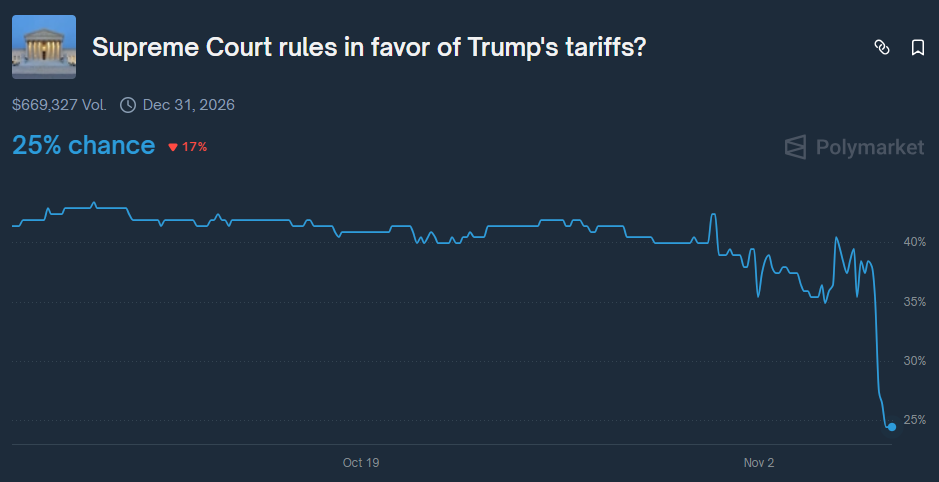
The US government has collected $151 billion from customs duties in the second half of 2025 alone, a nearly 300% increase over the same period in 2024.
Should the court rule against the tariffs, potential refunds could reach approximately $100 billion.
The court has not indicated a date on which it will issue its final ruling, though the Trump administration has requested an expedited decision.
Shutdown Becomes Longest in US History
The US government shutdown entered its 36th day today, officially becoming the longest in history. It surpasses the previous 35-day record set during Trump's first term from December 2018 to January 2019.
The Senate has failed 14 times to advance spending legislation, falling short of the 60-vote supermajority by five votes in the most recent vote.
So far, approximately 670,000 federal employees have been furloughed, and 730,000 are currently working without pay. Over 1.3 million active-duty military personnel and 750,000 National Guard and reserve personnel are also working unpaid.
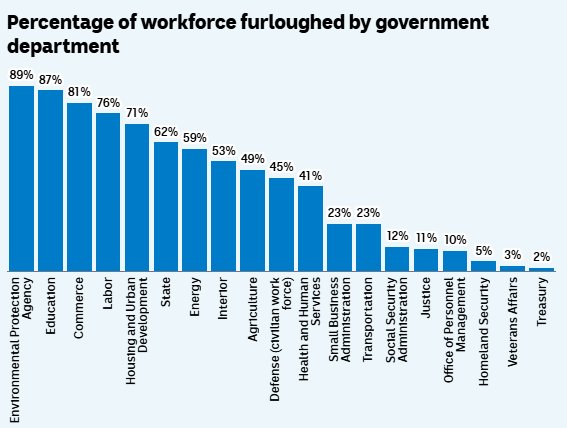
SNAP food stamp benefits ran out of funding on November 1 — something 42 million Americans rely on weekly. However, the Trump administration has committed to partial payments to subsidise the benefits, though delivery could take several weeks.
Flight disruptions have affected 3.2 million passengers, with staffing shortages hitting more than half of the nation's 30 major airports. Nearly 80% of New York's air traffic controllers are absent.
From a market perspective, each week of shutdown reduces GDP by approximately 0.1%. The Congressional Budget Office estimates the total cost of the shutdown will be between $7 billion and $14 billion, with the higher figure assuming an eight-week duration.
Consumer spending could drop by $30 billion if the eight-week duration is reached, according to White House economists, with potential GDP impacts of up to 2 percentage points total.


Maturity, Yields, Par Values and Coupon payments. These are words that everyone has heard of but not many have a good understanding of what they mean. In this article all these complicated terms will be explained.
Please note that while this information is most relevant for physical bonds, it is still important to understand when dealing with CFD’s as they play an important role in how bond CFD’s are valued. What is a Bond? A bond is an instrument that is used by companies and governments and other entities to raise money through the issuing of debt.
There are different typed of bonds however, the simplest bonds are contracts in which an issuer (Company/Government) receives a payment from the purchaser or bond holder in exchange for the rights to interest plus the principal amount. For example, a government may issue a 10-year bond for $1000 in which they agree to pay 1% interest per annum which will equate to $10 per year. In addition, they will pay back the principal amount once the bond matures.
Key Terms Issuer – The entity that sells the bond initially and must make payments. Holder – The entity who is possession of the bond. Principal – The amount of debt that the government/company has taken that will be paid at maturity.
Par Value – The nominal value of the bond or the price when it was issued. Coupon Payment - The interest payment that is paid to the bond holder. Yield –The coupon payment divided by the Bonds face value.
Maturity – The date when the principal amount of the bond will be paid back. Bond Ratings Generally, Bonds are rated according by agencies, based on how safe the underlying assets are. For instance, government bonds tend to be rated the highest as they are guaranteed by the government, and governments are highly unlikely to default.
In a practical sense, the US government is such a reliable issuer that it should never default on the repayments. This makes Bond’s a great asset to act as a hedge against unsystematic risk. On the other hand, corporate bonds may be given lower ratings depending on their credit risks.
Inverse Relationship between Bond Price and Yield The price and yields for bonds are inversely related. This is important to note as bonds are often charted against their yield and not price which is how derivatives are often charted. Therefore, a trader should be aware of the inverse relationship between price and yield.
This occurs because as the price of a bond changes up or down the interest rate must adjust to ensure that the coupon payment is the same. Assume Bond A is issued at $1000 dollars and 10% interest rate to pay a $100 coupon. 1 Year later that same bond is now priced at $900, however the bond must still pay out a $100 coupon. However, to get a coupon payment of $100, the interest rate must increase.
The formula below shows this: $900 x Interest Rate = 100. Simple Algebra shows that the interest rate = 11.1% Understanding this relationship will make eliminate one of the more confusing elements of trading bonds. Catalysts for Bond Prices The general factors that influence a bond’s price are related to the interest rates and the broader economy.
For instance, if the market interest rate 2% and the bond’s coupon rate is 1%, then the bond will trade at a lower price and vice versa. Subsequently, bonds can be a handy way of tracking the sentiment as they often reflect the feeling in the market. Economic events can impact on the performance of bonds.
When the economy is growing and equities are doing well, bonds tend to perform worse as the return is limited. However, during times of volatility and poor stock market performance, the bond market tends to perform better as the market looks for safety in the guaranteed returns from bonds. Inflationary pressure and low or high interest rates can influence the direction of the way in which bonds are traded.
Generally, in a strong economic market, bonds with longer maturities tend to have higher yields than those in shorter maturity. This is generally due to the thought that the time that is further in the future will has more uncertainty than that in the near-term future. The general exception to this is when the market expects a recession soon.
This causes what is known as an inverted yield curve, in which the shorter-term bond is yielding a higher interest then the long-term bonds. You can trade CFD on the 10 Year US treasury note, 5 Year US treasury Note, UK Gilt, Euro Bund and the JGB Japan Futures on Go Markets Metatrader 5 platform
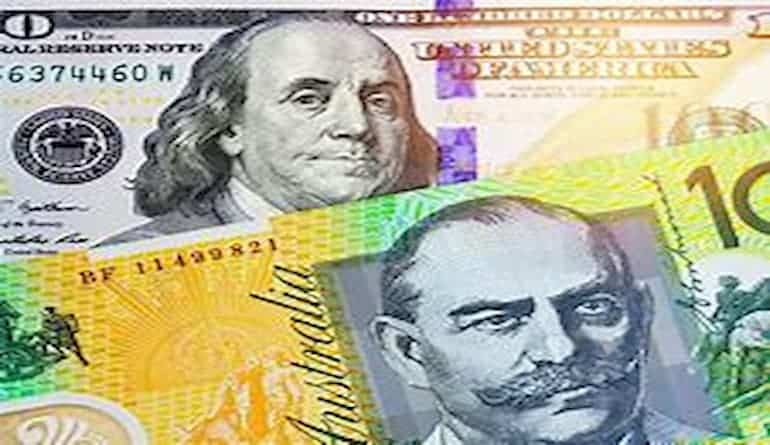

The AUD has fallen to lows not since the beginning of the Covid 19 pandemic and does not look like stopping anytime soon. With global commodity prices coming down and fears of a recession causing panic sell offs the AUD has been victim to a two-fold attack. The general recession fears push growth assets including the Australian dollar downward as investors look to put their money into safer assets.
In addition, as the USD has increased commodity prices have come down. Going forward, with presumably with recessionary fears only set to get worse globally and inflation in Europe and the UK potentially reaching 20% central banks have had no choice but to be aggressive with their monetary policy. The slowing growth has been a cause for concern as growth assets alongside the AUD have sold off.
Therefore, until there is really a peak in inflation or signs from the Federal Reserve that it intends to back off its hawkish stance, the AUD may very well continue to dive. Technical Analysis On the weekly chart the price currently in a nosedive with no obvious support in sight. The closest support in still $0.04 away at $0.60 which were the GFC lows.
If that level goes, then the next target is $0.55 which was the price during the initial stages of the Pandemic. Just as concerning is the fact that the 50-week moving average is almost ready to cross below the 200 week moving average. This is a lagging indicator that shows that the pair is very much being controlled by the sellers.
In addition, the RSI also still has room to drop further down to reach the level of the Covid 19 levels. The daily price chart confirms the analysis above and if anything shows a more systematic down trend. With both 50 day and 200 day moving averages trending down it does not bode well for a reversal any time soon.IN addition, the price has not been able to breakthrough both averages at for a significant period since June 2021.
Whilst the market can turn quickly, there is still s much fear and panic around that it is hard to see the AUD turning in the short term.
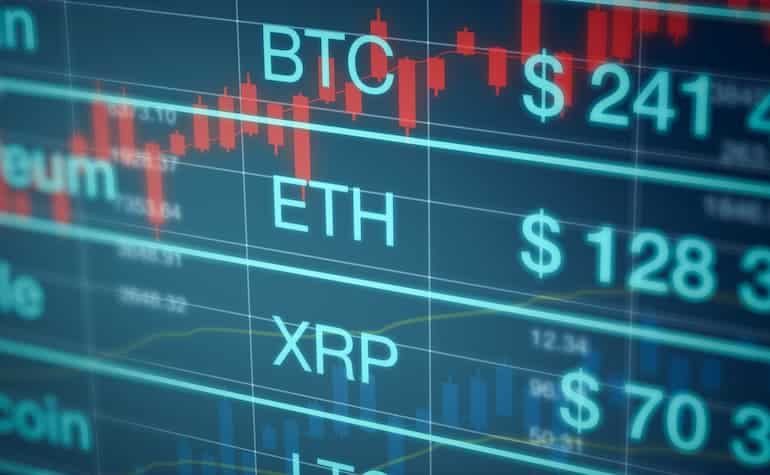

Following the previous Bitcoin analysis ( https://www.gomarkets.com/au/articles/economic-updates/bitcoin-usd-technical-analysis/ ), bitcoin continues to break below pattern after pattern, recently breaking out and re-testing a descending flag pattern on a 4h time frame as seen below: With the next major support sitting around $17,619, it won’t be a surprise if bitcoin comes down to that area. Looking at the correlation between Bitcoin and Ethereum, the last 7 days of price action shows a correlation of.89, which is a positive value that indicates a positive correlation between the two. A positive correlation means that the two moves very similar to one another. [caption id="attachment_273298" align="alignnone" width="602"] (https://cryptowat.ch/correlations)[/caption] [caption id="attachment_273299" align="alignnone" width="527"] (https://cryptowat.ch/correlations)[/caption] For ETHUSD (Ethereum), making similar patterns to BTCUSD, has also recently broken out of a descending flag pattern, signalling a probable continuation of the 4h downtrend, there is a high probability of ETHUSD reaching the next major support around $1012.
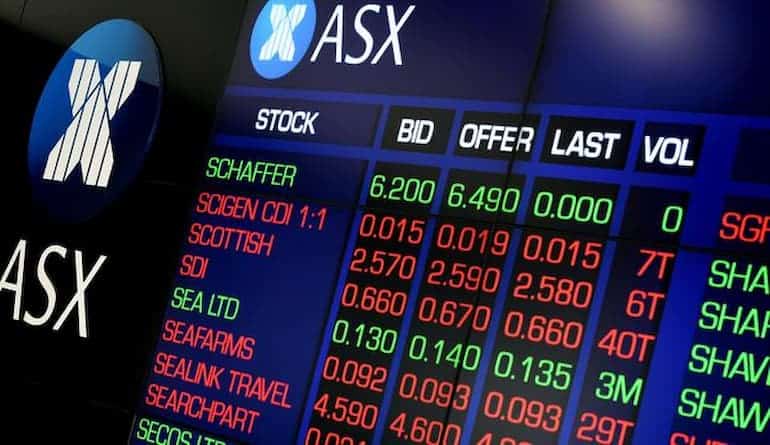

Inflation and recessionary pressures have caused the aggressive sell offs of some of the largest global indices, however so far, the ASX200 or XJO has fared relatively well. However, there are worrying signs that a resilient XJO may be coming to an end. Whilst the inflation rate in Australia is still at levels that are low compared to much of the rest world giving the Reserve Bank of Australia flexibility in how it attacks the inflation problem.
The Australian dollar has seen a sell off as commodity prices have come falling. In addition, as risk sentiment has shifted money has moved away from the AUD as it is seen as a drop which has not been helpful to the overall Australian market. At the same time the USD has been on an absolute tear as market players look to move their money into safer asset classes.
The broader macroeconomic factors and connectiveness of global markets is beginning to take its toll on the XJO. With the outlook in America looking very bearish and the UK and Europe looking likely to enter a recession has already caused some aggressive selling in Australia especially across its growth companies. This XJO has dropped to its lowest level in more than 6 months.
The weekly price chart shows that the recent sell off is ready to test the long-term support zone between 6300-6500 points. In addition, the price has broken through the 200-week moving average which is a cause for concern as it may indicate that the bearish trend will continue. Another concern is that the RSI which has been a reasonable predictor of the bottom of pullbacks is yet to reach the same oversold level as it was on the previous bounces, which may indicate that there is more selling to come.
The daily chart is slightly more encouraging. Although it still shows the price of the XJO testing the support zone, it does show that the price has already bounced off the support. However, as the week progresses, there may still be cause for the index to drop further, especially if the conditions in the US and Europe continue to worsen.
With the recessionary fears dictating much of the direction of the market, a break through the support zone is still a realistic possibility in the short term.


The USDJPY has been one of the strongest performing currency pairs since the beginning of the year. With geopolitical volatility and record high inflation rates impacting the global economy, the strength of the USD has just continued to be on show. On the contrary, the JPY has been pillaged from pillar to post as the Bank of Japan has refused to change form its dovish stance and remain one of the few countries committed to holding interest rates low in the medium term.
The different responses The US Federal Reserve has become extremely hawkish with its monetary policy, after describing inflation as transitory only last year. After recording extremely hot CPI and Core CP figures for the last month as the yield on US government treasuries has increased and trader price in more interest rate hikes. Conversely the BOJ has continued to keep a 0.25% cap on its 10-year government bonds.
On the other hand, a weak JPY makes the cost of importing energy and food more expensive in Japan. This is especially problematic as the global energy crunch and inflation have sent the price of these goods and commodities sky rocketing. The BOJ has also continued to buy up government debt stimulating the economy which has further weakened the currency.
However, unlike, much of the rest of the world, Japan’s inflation level is still relatively low. These actions of both banks and the current economic climate has led to a situation where the USDJPY is currently at 30-year highs and only looking to go higher. The price has been going up aggressively since 2021 has been an aggressive upward trend.
Since March 2022 the price has sped up and broken through decade high levels. The BOJ has so far been unwilling to change, at least until April 2023 meaning there is little to stop the JPY continuing to fall. On the other side, with the Federal Reserve set to continue raising rates there is nothing to stop the USD from continuing to climb.
Technical Analysis In recent days the price has begun to consolidate into a flag or pennant pattern. As it can be seen on the chart, the price has reduced its range and volume as it has paused amid its push upward. A pattern like this is not unexpected and is standard of a strong upward trend.
In addition, with important economic events to come like the FOMC meeting and the shift in federal funds rate, the USD may increase its strength if the rates incur an unexpectedly increase in rates. The next target if the price does break out of the triangle is 147 and then 160. Various economic events can still play a role in either pushing the price up or down.


AutoZone Inc. (AZO) reported its fourth quarter financial results for the period ending August 27, 2022 on Monday. The largest US retailer of aftermarket automotive parts reported revenue of $5.348 billion (up by 8.9% from the same period last year) vs. $5.164 billion expected. The company reported earnings per share of $40.51 for the quarter vs. $38.51 earnings per share expected. ''Our results are a testament to our AutoZoners’ ongoing commitment to delivering exceptional customer service every day.
Our retail business performed well this quarter ending with positive same store sales on top of last year’s strong performance. And, our commercial business growth continued to be exceptionally strong at 22%. The investments we have made in both inventory availability and technology are enhancing our competitive positioning.
We are optimistic about our growth prospects heading into our new fiscal year,'' Bill Rhodes, Chairman, President and CEO of AutoZone commented on the results. During the quarter, AutoZone opened 118 new stores and closed one in the United States. As of August 27, 2022, the company had 6,943 stores within the United States (6,168), Mexico (703) and Brazil (72).
AutoZone Inc. (AZO) chart Shares of AutoZone were down by around 2% on Monday, trading at $2100.66 a share. Stock performance 1 month: -6.28% 3 months: +8.69% Year-to-date: +3.30% 1 year: +36.62% AutoZone price targets UBS: $2260 Wells Fargo: $2450 Raymond James: $2350 Goldman Sachs: $2296 Morgan Stanley: $2420 Citigroup: $2250 JP Morgan: $2200 AutoZone is the 364 th largest company in the world with a market cap of $42.20 billion. You can trade AutoZone Inc. (AZO) and many other stocks from the NYSE, NASDAQ, HKEX and the ASX with GO Markets as a Share CFD.
Sources: AutoZone Inc., TradingView, MetaTrader 5, Benzinga, CompaniesMarketCap

